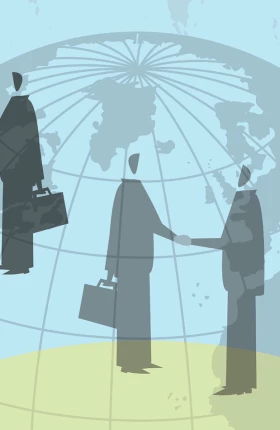Later this year, BCG will launch the Centre for Public Impact, a not-for-profit global foundation that will bring together world leaders to learn, exchange ideas, and share stories of government impact from around the world. The government of New Zealand’s successful efforts to harness the power of digital technology exemplifies how policy makers can deliver better outcomes for citizens.
Where are you reading this? At home or at your desk? Perhaps you’re on the train to work. Or maybe you’re in between meetings or at the airport. Wherever you are, your smart mobile device is likely to be within reach. In our world of apps, tablets, cloud computing, and social networks, you’re one of billions of people connected around the world via an ever-expanding list of platforms and software systems.
The digital revolution has penetrated deep into business and society, bridging generational divides and bringing countries, communities, and individuals ever closer together. Governments, too, are seeking to tap into this richly transformative phenomenon. Today’s policy makers increasingly rely on technology to deliver public services, and some are also using it to make open government a genuine reality. Voters used to shopping or banking online at any time of the day or night now expect the same convenience when dealing with their public services—a fact long recognized by Richard Foy, the general manager of digital transformation in New Zealand’s Department of Internal Affairs.
“New Zealand has some unique conditions and some capabilities in the system that enable us to deliver a different digital experience from what many other countries are trying to do,” he says. “We are looking at it from the outside in. We undertook some customer research last year to really understand citizens’ pain points and their service journeys with government. This has underpinned our new push toward integrated services and digital delivery; there is an opportunity to integrate and generate value using the digital environment.”
A Results Business
Foy’s is by no means a lone voice among his compatriots. New Zealand has, in many ways, spearheaded the global push for the digitization of services in the public sector. In 2012, the nation’s government set ten challenging goals, or key results, for the public sector to achieve during the subsequent five years. One of those goals—Result 10—is for New Zealanders to be able to “complete their transactions with government easily in a digital environment.” Foy, who leads the efforts to achieve Result 10, says that it isn’t about saving money but rather about enhancing service delivery.
“The key is to focus on the areas that would really drive outcomes and improvement for New Zealanders and the New Zealand economy,” he points out. “We have never emphasized outcomes like reduced cost of services or savings, but these would be by-products of better outcomes for New Zealanders.” An early sign of things to come was the successful introduction of a new online passport system: within two years, 300,000 passports—40.3 percent of all adult renewals—had been renewed online, and the number is growing.
Much emphasis has been placed on how agencies can deliver better services while working together to explore opportunities, share capabilities, and overcome common challenges. An abiding ambition, though, has been to place customers at the center of service design and delivery. In practice, this means changing the way the government orchestrates and delivers services with regard to customers’ requirements at different points in their lives—a life events model.
“Our research told us that people had to deal with a number of government agencies during critical life events and transitions, and it was of increasing frustration that we were just so fragmented in our service offerings,” says Foy. “They continually had to repeat themselves—not just to provide identity information but also to satisfy other requirements around determining eligibility for various entitlements. Government wasn’t looking at it from a customer’s perspective.”
Surprisingly, the research also found that demographic background has a less significant effect than expected on how people experience public services. “We found that if you have to deal with more government agencies, then you are more likely to have a poor experience with government,” adds Foy. “We need to make sure that when we improve the experience for a certain customer segment, like a parent around a certain life event, it will be connected and underpinned by the same design, interactions, and data when that person transitions to a different context.”
Foy and his colleagues are working on transforming the first life event: the birth of a child. In this effort, the departments of internal affairs and internal revenue are collaborating with the ministries of health and social development. They are codesigning the new service with a variety of expectant parents to create a service offering that enhances the interactions with government leading up to childbirth, and then provides online access to the new parents’ subsequent entitlements.
“It’s a pretty unnatural way for us to do things,” admits Foy. “We have taken the first step and launched our online birth-registration service, and uptake has exceeded our expectations. We have decided to do this from the outside in, to prioritize customers’ needs and have these agencies work together. We want to use this as a start-up example and then run other initiatives through a similar process. The next one is likely to be based on immigration, and we are also doing some work in the social-services sector, getting one of the agencies there to look at the life event of when someone retires.”
RealMe, Real Progress
So, how has New Zealand sought to put this thinking into practice?
Underpinning this new approach is a new capability, called RealMe, that enables New Zealanders to quickly and securely prove their identity online and access more than 50 government services with the convenience of just one username and password. The service is designed to protect users’ privacy and security, so they can log in to different organizations in both public and private sectors. A RealMe verified identity allows users to share identity and address information online with participating organizations, such as their bank or other financial-services organization.
“It’s a systemwide asset that is quite sophisticated and reasonably unique when compared with other jurisdictions,” says Foy, who pinpoints the system’s ability to offer secure identity and enable joined-up services as critical features. “We are trying to get this delivery model into other agencies’ transformation projects. We’re working with ministers to ensure that agencies incorporate and prioritize this in their plans, as well as driving the broader uptake around RealMe.”
Citizens First and Always
Ministers have set a 2017 deadline for the radical transformation of public services to benefit all New Zealanders, and there is little doubt that Foy and his team are keen to keep up the momentum toward better, faster digital services. “The opportunity for us is different than it is for other jurisdictions, which are still just driving up digital services within quite narrow silos and are not yet taking a really cohesive and integrated approach for the citizen,” he says. “The idea of a true ‘citizen account’ with government is quite enduring. It allows government to recognize an individual as the same person during interactions sparked by different life events.”
The initial target of the key result was to enable the digital processing of 70 percent of New Zealanders’ most common transactions with government by 2017. And certainly, more and more citizens choosing to perform transactions online or via other digital services—rather than at the counter, contact center, or post office—tells a powerful story in itself. Foy, though, is not taking anything for granted. “What we’re working on right now is redefining the way we measure our performance to incorporate service experience, satisfaction with service experience, and how well the government is joined up for the customer.”
With the ministerial spotlight remaining intense, Foy goes on to say that the ability to point to real, clear-cut examples of progress will be important. “We need to be able to report back to the cabinet and to the public and say that we are seeing a shift in this,” he points out. “The best way to do this is to actually deliver these life events initiatives and get them out the door.”
Based on the track record so far, New Zealanders are clearly well positioned to reap the digital benefits of such efforts, both now and in the future.





